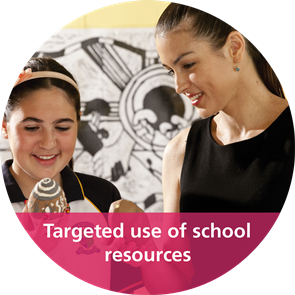
Targeted use of school resources
Description
Staffing, physical and technological resources are applied through school-wide policies that are aligned to system and local priorities, to address the well-being and learning needs of students.

NSW School Examples
 |
The Deputy Principal of Batemans Bay Public School on the NSW South Coast, describes how the school leadership drove their explicit whole school improvement agenda to upskill teachers so they could change their teaching to best address the needs of students. The school chose to invest time and resources in selecting the most effective tools to address the learning needs of students. |
 |
The Principal of Farmborough Road Public School, south of Wollongong, reflects on the use of evidence to select a numeracy strategy and the ongoing analysis of student data to embed a sustainable, whole-school approach. The evidence formed the basis of targeted investments in physical and human resources. |
 |
This Powerpoint from Ingleburn Public School in south-west Sydney, describes the critical role of transformational leadership in the use of data to inform classroom practice across the whole school. The school allocated and managed human resources effectively across the whole school to support the continuous improvement of student outcomes. |
 |
A Powerpoint from Sawtell Public School describes an approach to making sustainable resourcing decisions, especially for purchasing technology to deliver numeracy programs which meet individual learning needs. |
-
Targeted use of school resources - in detail
An effective basis for resourcing decisions
Highly effective principals align the skills of teachers and focus resources within the framework of demands of the particular programs or approaches to be implemented. Undertaking this process efficiently across a whole school saves critically important time in preparing for and implementing change.
Many NSW case study schools (Erebus International, 2012 and 2013) needed time to adjust to the sudden arrival in the school of new Literacy and Numeracy National Partnership funds that allowed purchase of resources on a scale not previously possible. While some schools acknowledged a level of uncertainty about the most expedient way to expend the funds, others used the school's change agenda in literacy/numeracy and the accompanying annual action/strategic plan as the fundamental tool for negotiation with the school community.
Where the school plan identified priorities that were clear and understood by all stakeholders, the most effective use of resources was less of a challenge. On reflection, some principals would concede that too much was initially invested in physical resources and insufficient in human resources that could be employed to build teacher capacity, and to support the accompanying organisational change and longer term sustainability.Adapting resource decisions to suit changing needs
Principals in case study schools also reported a change in emphasis over time of the need for physical or human resources. Most commonly the most effective strategy appears to have been the early expenditure predominantly on human resources with some emphasis on physical resources, and then reversing these priorities after evidence of initial impact.
Investing in people to build lasting capacity
The NSW school case study findings accord directly with both Zbar et al (2010) and Hattie (2009) who suggest that most highly effective school leaders are very diligent about ensuring that resources are selected to maximise the learning impact for students. Often this meant the early identification and employment of educators with the relevant skills to facilitate change. Sharing of that expertise/understanding with professional colleagues then enhanced teachers’ capacity to support the change process.
References
Erebus International (2012). Evaluation of the take-up and sustainability of new literacy and numeracy practices in NSW schools – Final Report for Phase 1, undertaken on behalf of the NSW Minister for Education
Erebus International (2013). Evaluation of the take-up and sustainability of new literacy and numeracy practices in NSW schools – Final Report for Phase 2, undertaken on behalf of the NSW Minister for Education
Hattie, J. (2009) Visible Learning: a synthesis of over 800 Meta- Analyses relating to Achievement. London: Routledge
Zbar, V.,Kimber, R. and Marshall, G. (2010). Getting the Preconditions for School Improvement in Place: How to Make it Happen. Centre for Strategic Education Seminar Series Bulletin 193: Melbourne
Whole school factors
Resources are focused specifically on what students need to learn in response to needs that have been systematically identified.
Classroom/teacher factors
Specific intervention programs and tailored resources are one of the tools for enhancing student learning outcomes
See also
For a portal into a wide range of resources designed to support innovative and cost-effective services across all sectors of education, explore the Education Services Australia (ESA) website.
Scootle provides digital resources to learn, teach and collaborate for the delivery of the Australian Curriculum. Resources include Teaching Teachers for the Future and ICT in Everyday Learning: Teacher Online Toolkit.

